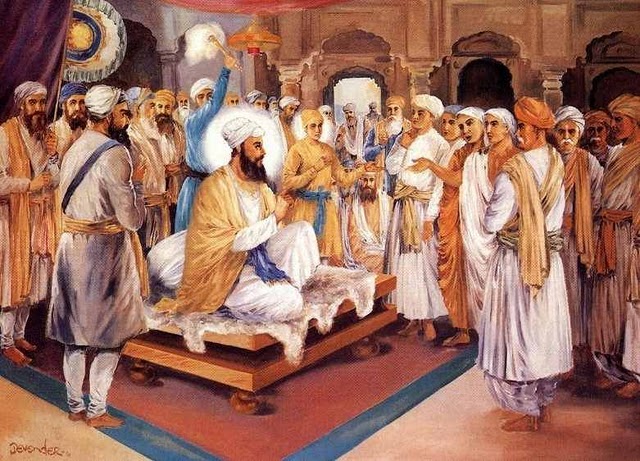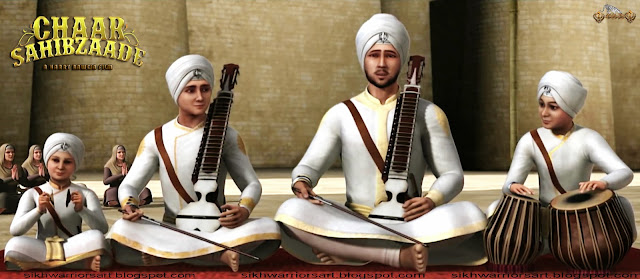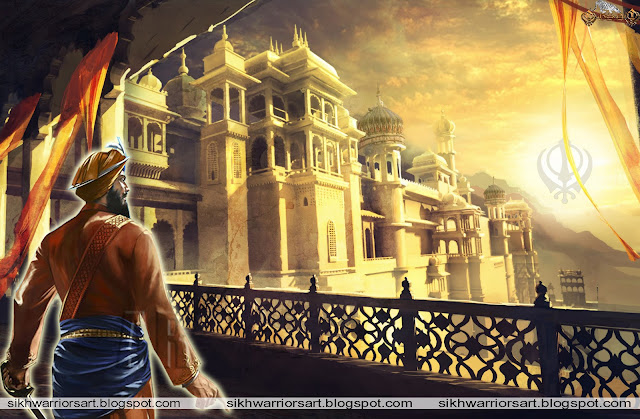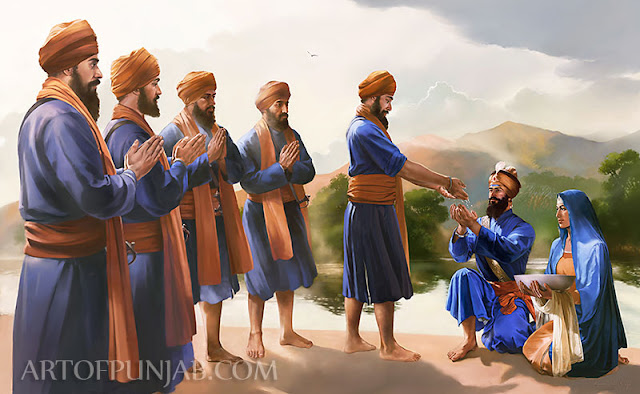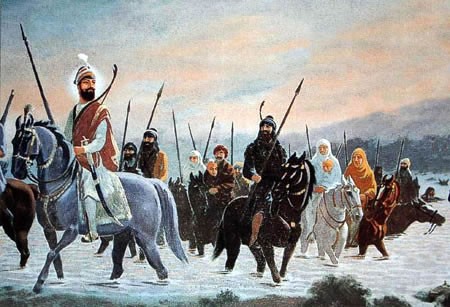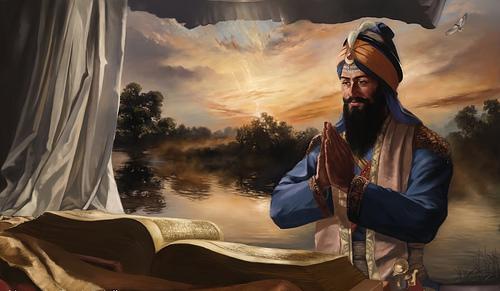
“The personality of Guru Gobind Singh is like Rainbow. He have Honeyed Humility (ਮਿਠਤ ਨੀਵੀ ) of Guru Nanak Dev ji, Lamblike Virtue (ਕਰੁਣਾਜਨਕ ਦ੍ਰਿਸ਼ਟੀ) of Jesus Christ, Spiritual Wisdom (ਆਤਮ ਗਯਾਨ) of Gautam Buddha, Bubbling Energy (ਜੋਸ਼ ) like Prophet Mohammad, Sunkissed Glory (ਸੂਰਜ ਦਾ ਤੇਜ) like Krishan and Abiding discipline (ਮਰਯਾਦਾ ਪੁਰਸ਼ੋਤਮ) and Royal glamour (ਸ਼ਾਹੀ ਸ਼ਾਨ) like Rama seen in his personality.” T.L.Vaswani Writes about Guru Gobind Singh.
1. Family and Early Life
► Birth and Childhood

Guru Gobind Singh Ji (Gurmukhi: ਗੁਰੂ ਗੋਬਿੰਦ ਸਿੰਘ) (January 5, 1666-21 October, 1708), was the only son of Guru Teg Bahadur, the ninth Sikh guru, and Mata Gujri ji. He was born as “Gobind Rai” at Patna Sahib, Bihar, India, was the tenth Nanak or last of the human form Gurus/preachers of Sikhism. His teachings have inspired the Sikh community and all Human beings for generations. He became Guru on November 24, 1675 at the age of nine, following the martyrdom of his father, the ninth Guru, Guru Tegh Bahadur Ji.
► Marriage and Children
On 4th April, 1684, while still in Anandpur, Guru Gobind Singh was married to Mata Jito, also known as Mata Sundari the daughter of Bhai Ram Saran, a Kumarav Khatri of Bijvara, in present-day Hoshiarpur district of the Punjab.Four sons were born to Mata Jitoji/Sundariji Ajit Singh (7 Jan 1687), Jujhar Singh (14 March 1691), Zorawar Singh (17 November 1696) and Fateh Singh (25 February 1699)
► Mother of Khalsa-Mata Sahib Kaur ji
Mata Sahib Kaur, a follower of the tenth Sikh Guru, Guru Gobind Singh Ji was born in 1681 at Rohtas, Jhelum. Her parents, Mata Jasdevi Ji and Bhai Rama ji were ardent devotees of Guru Gobind Singh Ji. The devotion of her parents to Guruji influenced her very much and she also decided to devote her whole life in the service of Guru Gobind Singh Ji.

When the proposal of her marriage was brought for discussion to Anandpur, Guru Gobind Singh had already been married. Therefore, Guruji said that he could not have another wife since he was already married.But Sahib Deva from her heart & mind already accepted guru ji as her husband. Finally, Guruji agreed for her to stay at Anandpur but without accepting her as his wife on the term that the relationship with Mata Sahib Deva would be of a spiritual nature and not physicaland this is called ‘Kuwara Dolla’ also. The question arose, as most women desire to have children, how she could have one without being married. Then Guruji told that, “She will be the ‘mother’ of a great son who will live forever and be known all over the world.” Guru Gobind Singh Ji blessed her by giving her a unique title of “MOTHER OF KHALSA”.
2. Scholar and Warrior
Guru Sahib learned many languages including Sanskrit, Urdu, Hindi, Braj, Gurmukhi and Persian. Guru Gobind Singh’s literary heritage was very rich. Guru Gobind Singh, employed literature to the service of mankind. With its help they tried hard to shape the psyche of the people to enable them face the challenges for all times to come.Quite a large number of compositions were produced by the Guru himself Like Jaap Sahib, Akaal Ustat, Chandi di Vaar,Bachiter Natak,Swayaas, Zafarnaama,Shabad Hazare etc
ਧੰਨ ਜੀਓ ਤਿਹ ਕੋ ਜਗ ਮੈ ਮੁਖ ਤੇ ਹਰਿ ਚਿੱਤ ਮੈ ਜੁਧੁ ਬਿਚਾਰੈ ॥
Blessed and auspicious is the soul who in this world through his mouth and in his mind fights the war of righteousness
He also learned martial arts to become adept in self defense & combat. He also realized that a robust body is essential not only to fit the man for the rigors of soldiering but also to bring about alertness of mind and coordination which, along with physical fitness results in true mobility.Martial games and physical exercises were conduced regularly. These involved physical conditioning and toughening of the troops. Prizes were given to the most able bodied.
3. Guru Gobind Singh Ji’s Love For Art

Guru Gobind Singh Ji cherished all kinds of art. He invented the musical instrument Dilruba (Esraj) which is used by many renowned modern musicians like The Beatles and AR Rahman in their musical compositions. It is said that there were 52 celebrated poets in the Guru’s darbar (court) and Bhai Nand Lal Goya is one of them.
ਬਰ ਤਰ ਅਜ਼ ਹਰ ਕਦਰ ਗੁਰੂ ਗੋਬਿੰਦ ਸਿੰਘ ॥
Guru Gobind Singh supreme in all virtues.
ਜਾਵਿਦਾਨੀ ਸਦਰ ਗੁਰੂ ਗੋਬਿੰਦ ਸਿੰਘ ॥ ੧੪੪ ॥
He is eternal and above everyone else.(Bhai Nand Lal Goya)
4. Guardian of Human Rights
ਭੈ ਕਾਹੂ ਕਉ ਦੇਤ ਨਹਿ ਨਹਿ ਭੈ ਮਾਨਤ ਆਨ ॥
One who does not frighten anyone, and who is not afraid of anyone else
ਕਹੁ ਨਾਨਕ ਸੁਨਿ ਰੇ ਮਨਾ ਗਿਆਨੀ ਤਾਹਿ ਬਖਾਨਿ ॥੧੬॥
– says Nanak, listen, mind: call him spiritually wise. ||16||
Human Rights word come in existence When, the Kashmiri Pandits had approached Guru Tegh Bahadur Jee Maharaj, seeking his help to stop the forced conversions that were being carried out by Aurangzed, Guru Gobind Singh Ji ( then called Gobind Rai) who was just nine years old, came running to his father’s lap, and asked him what was the matter. Guru Jee replied, “These people are in trouble. It would require the sacrifice of a great man to save their faith/thier religion”. Gobind Rai replied ,”Father, there is no soul greater than you at this time on earth. You should go ahead for the sacrifice.”Thus at the age of nine years, little Gobind Rai, is only the one example in the history who encourage and sent his father to safeguard the interest of Kashmiri Pandits (Hindus) by sacrificing his human frame.
5. Son of a Martyr & Father of Martyrs
Guru Gobind Singh is only Human beeing in whole universe who is Son of Martyr and Father of Martyrs. The father of Guru Gobind Singh Nine Nanak,Guru Teg Bahadur scrifice his life for safe guard other’s religion (Hindu Religion) on 24 November 1675 at Chandni Chowk, Delhi, India, when Gobind Rai was only Nine years old.
ਜਬ ਆਵ ਕੀ ਅਉਧ ਨਿਦਾਨ ਬਨੈ ਅਤ ਹੀ ਰਨ ਮੈ ਤਬ ਜੂਝ ਮਰੋਂ ॥੨੩੧॥
When the end of my life comes, then I may die fighting in the battlefield.231.
The Chaar Sahibzaade (Sons) of Guru Gobind Singh ji also Martyr, two (Baba Ajit Singh January 7, 1687 – December 22, 1704 only 17 Years Old and Baba Jujhar Singh March 1689-December 22, 1704, 15 Years Old Martyre in Battel of Chamkaur with fought 10 Lacs Army of Mugals and Hindu Pahadi (hill) Kings and two younger sons, Baba Zorawar Singh (17 November 1696-Dec 27,1704) and Baba Fateh Singh (25 February 1699-Dec 27,1704) in age of 7 and 5 years were Masonry alive in walls at Sarhind Fatehgarh Sahib.
6. The Battle Against Oppression
ਚੁ ਕਾਰ ਅਜ਼ ਹਮਹ ਹੀਲਤੇ ਦਰ ਗੁਜ਼ਸ਼ਤ ॥ ਹਲਾਲ ਅਸਤ ਬੁਰਦਨ ਬ ਸ਼ਮਸ਼ੀਰ ਦਸਤ ॥੨੨॥
When all other methods fail, it is proper to hold the sword in hand. (22)
The battles fought by Guru Ji never had a political intent, he fought only against injustice, and to preach his Divine message. He always taught that one must pick up the sword, only when all other methods of curbing oppression have failed.He is the only person, in the whole world who fought for injustice, even after so many victories, he never conquered any region of world & sacrificed his whole family & relatives to stop injustice to humanity.Guru ji fought 14 battles some of them are :
The Battle of Bhangani (1689): In September 1688, at the age of 19, Guru Gobind Singh fought the Battle of Bhangani against an allied force of Bhim Chand, Garwal king Fateh Khan and other local kings of the Sivalik Hills.The battle lasted for a day and thousands of lives were lost. The Guru came out victorious.
The Battle of Nadaun (1690) : Won against Mughals, in response to a request from Raja Bhim Chand.
The Battle of Anandpur Sahib (1700): Against combined forces of the Mughals and the Hill Rajas. After a prolonged Siege, the Guru left Anandgarh Fort.
The Battle of Chamkaur (1704): Forty Sikhs with the Guru fought valiantly against thousands of the enemies, and became martyrs. The two elder sons of the Guru also martyr fighting in this battle.
The Battle of Muktsar (1704): Forty Sikhs, who had abandoned Anandpur Sahib, returned to the Guru and sacrificed their lives while fighting in his defence against a Mugal Army. They became martyrs and the Guru blessed them as “MUKTAS”.
7. As a Leader Creation of the Khalsa – The Way of Life
ਆਗਿਆ ਭਈ ਅਕਾਲ ਕੀ ਤਬੀ ਚਲਾਇਓ ਪੰਥ ।
Under the orders of the Immortal Being, the Panth (Religion) was created.
India was 1000 years of slavery under different foreign races. When people were forced to accept Islam and those who denied were killed, tortured and murdered.Hindus except Rajputs will not ride on elephant, fine horses, in palanquins or carry arms.Indian Hindus were divided in castism and caught in Ritualism. People were afraid and life of them was total hell. That time Guru gobind Singh Create KHALSA PANTH with sacred Bani and Amrit Sanchar on day of Baishakhi 1699. He Make Sant & Soldiers to fought against injustice of rural and ritualism of religious priests. In a brilliant move of strategy and leadership, Guru Gobind Singh transformed the Sikhs into the fearless and united body of the Khalsa.
With the creation of Khalsa Guru Gobind Singh permanently erased any caste differences that may have lingered on within the Sikh society of the time. In 1699, when the rest of the world was still practicing slavery and caste system Guru Gobind Singh declared all humans as equals. Guru Gobind Singh declared that a quorum of 5 Sikhs shall mean a presence of the Guru himself. He Gave his followers such an identity that never can be hidden.
8.The Panj Pyare – The Five Beloved of Guru
1.Bhai Daya Singh(1661-1708)-The meaning of the term “Daya” is “merciful, kind, compassionate.
2.Bhai Dharam Singh(1666-1708)-The meaning of “Dharam” is “righteous living.
3.Bhai Himat Singh (1661-1705)- The meaning of “Himmat” is “courageous spirit.”
4.Bhai Mohakam Singh (1663-1705)-The meaning of “Muhkam” is “strong firm leader or manager
5.Bhai Sahib Singh(1662-1705)-The meaning of “Sahib” is “lordly or masterful.”
Basic meaning of these five is a way of living life. when someone have “Daya” Mercy in his heart only than one can be on the way of “Dharam” or religion and who is on the way of Dharam/religion never afraid any one or any evil he has such a “Himat” or Courageous spirit.Who have Himat/Courageous Spirit always victorious on every enemy or inner evil thats called “Mohakam” or free from all evils and at last who is free from all evils become a part of “Sahib” or Waheguru/God. This is whole the meaning of these five beloved of Guru Gobind Singh Ji that teach us the way of life.
9. The equality of Human Being – Singh and Kaur
ਹਿੰਦੂ ਤੁਰਕ ਕੋਊ ਰਾਫਜੀ ਇਮਾਮ ਸਾਫੀ ਮਾਨਸ ਕੀ ਜਾਤ ਸਬੈ ਏਕੈ ਪਹਿਚਾਨਬੋ ॥
“Some are Hindus while other Muslims. some are Shias and
others are Sunnis. Man’s caste should be
considered as one”
At the gathering of 1699, Guru Gobind SIngh founded the Khalsa Vani – “Waheguru ji ka Khalsa, Waheguru ji ki fateh”. He named all his followers with the title Singh and Kaur. Singh means a lion and Kaur means a princess. In Sikhism these titles eliminate discrimination based on “family name” (which denotes a specific caste) and reinforces that all humans are sovereigns and equal under God.
10.The principles of the Five ‘K’s – The 5 Articles of Faith
The 5 Articles of Faith, given by Guru Gobind Singh that a baptised Sikh has to carry every time with him. When Guru Ji mandated it for all Sikhs, he united them under a unique physical appearance. The five ‘K’s are the five principles of life that are to be followed by a Khalsa has a great significance and a deep meaning behind them.
1.The Kesh (Hair)

The hair, is considered to be a gift of the Almighty and is supposed to be kept in its natural state. Guru Nanak Dev ji started this practice, and Guru Gobind Singh ji instructed the Sikhs to wear the Turban in order to protect it.
2.The Kangha or wooden comb – as a symbol of cleanliness
A Sikh is instructed to carry a comb, comb his hair twice a day and tie his turban neatly. The turban is worn to protect the hair and to promote social id
entity.
3.The Kara or iron braceletThe bracelet, worn on the right wrist, as a mark to remind a Khalsa of self-restraint.
4.The Kirpan
The sword symbolizes courage and self- defence, to defend oneself and the poor, the weak and the oppressed from all religions, castes and creeds.It embraces dignity and is a reminder of self dependence and reliance.
5.The Kacchera
The under shorts, reminds the Sikhs about the self discipline over rage, anger, lust and passion. If a Sikh ever gets caught in a moment of negativity, the Kachehra reminds him of his duties.
11.Humility and Temperance – Master and Disciple
Another good thing that we can learn from the Guru’s life is to remain humble and not to be elated when success licks our feet, and not to feel dejected when our efforts fail. He created an example of humility when he knelt before his five beloveds and requested to be baptized. Thus he gave his people a new status superior to himself. He advised his followers not to treat him as God. He considered himself an ordinary man of God. He was humble enough to give the credit of his achievements to his followers:
ਜੇ ਹਮ ਕੋ ਪਰਮੇਸਰ ਉਚਰਿ ਹੈ ॥ ਤੇ ਸਭ ਨਰਕ ਕੁੰਡ ਮਹਿ ਪਰਿ ਹੈ ॥ ਮੋ ਕੌ ਦਾਸ ਤਵਨ ਕਾ ਜਾਨੋ ॥ ਯਾ ਮੈ ਭੇਦ ਨ ਰੰਚ ਛਾਨੋ ॥
‘Those who call me God will fall into the pit of hell . Consider me as His (the Immortal Lord’s) servant, Understand that there is not one iota of discrepancy in this statement.
ਮੈ ਹੋ ਪਰਮ ਪੁਰਖ ਕੋ ਦਾਸਾ ॥ ਦੇਖਨ ਆਯੋ ਜਗਤ ਤਮਾਸਾ ॥ (Dasam Granth:132)
I am servant to the Supreme Lord. And have come to witness the pageant of this world.’
12. Respect all Religion and Their Sacred Things
ਨਾ ਕੋ ਬੈਰੀ ਨਹੀ ਬਿਗਾਨਾ ਸਗਲ ਸੰਗਿ ਹਮ ਕਉ ਬਨਿ ਆਈ ॥
No one is my enemy, and no one is a stranger to me. I get along with everyone (1299).
Under the pressure of a prolonged siege with food and ammunition exhausted, Guru Gobind Singh and 400 Sikhs left Sri Anandpur Sahib on the bitter cold and rainy night of December 20, 1704. The Mughals and Ajmer Chand’s league of Rajput Hill Chieftains had offered Guru Sahib a safe passage to leave Anandpur Sahib on an oath sworn on the Quran, an oath that had been signed by emperor Aurangzeb, as well as, an oath swore on the cow (which Hindus consider sacred) by the Rajput Chieftains. However, their respective ‘Holy’ oaths proved to be meaningless as they lost little time betraying their promises to Guru Sahib, almost as soon as the Sikhs had left the safety of their impregnable fortress.
13.About Superstious People and Masands
The Guru received various complaints against the priests, masands who robbed the poor People and misappropriated the collections. Guru Sahib abolished this order and severly punished the miscreants. Hereafter, the faithful were to bring their offerings directly to the Guru at the time of the annual Vaisakhi fair.
The Guru wanted to create a strong self-respecting community. He inspired the Sikhs with courage and heroism and a life of simplicity and hard work.
Once when the Brahmins insisted that he should offer worship or yug to goddess Durga in order to seal victory, he agreed and kept up the farce till nothing came out of it. At the crucial moment,the Guru unsheathed his sword exclaiming, “The sword is our Durga which will give us victory over our enemies”.
ਕਾਹੂ ਲੈ ਪਾਹਨ ਪੂਜ ਧਰਯੋ ਸਿਰ ਕਾਹੂ ਲੈ ਲਿੰਗ ਗਰੇ ਲਟਕਾਇਓ ॥
Some worship stones, borne on their heads; some hang lingams from their necks.
ਕਾਹੂ ਲਖਿਓ ਹਰਿ ਅਵਾਚੀ ਦਿਸਾ ਮਹਿ ਕਾਹੂ ਪਛਾਹ ਕੋ ਸੀਸੁ ਨਿਵਾਇਓ ॥
Some claim that God dwells in the south, whilst other bow to the West.
ਕੋਉ ਬੁਤਾਨ ਕੋ ਪੂਜਤ ਹੈ ਪਸੁ ਕੋਉ ਮ੍ਰਿਤਾਨ ਕੋ ਪੂਜਨ ਧਾਇਓ ॥
Some worship idols, foolishly ignorant; others put trust in the tombs of the dead.
ਕੂਰ ਕ੍ਰਿਆ ਉਰਿਝਓ ਸਭ ਹੀ ਜਗ ਸ੍ਰੀ ਭਗਵਾਨ ਕੋ ਭੇਦੁ ਨ ਪਾਇਓ ॥10॥30॥
All are astray, seduced by false ritual; none knows the secret of God
॥10॥30॥
14. Forward Looking
ਆਗਿਆ ਭਈ ਅਕਾਲ ਕੀ ਤਬੀ ਚਲਾਇਓ ਪੰਥ॥ ਸਭ ਸਿੱਖਨ ਕੋ ਹੁਕਮ ਹੈ ਗੁਰੂ ਮਾਨਿਓ ਗ੍ਰੰਥ॥
Under orders of the Immortal Being, the Panth was created. All the Sikhs are enjoined to accept the Granth as their Guru.
Guru Gobind Singh molded the Sikh religion into its present shape, with the institution of the Khalsa fraternity, and completion of the sacred scripture, the Guru Granth Sahib, in the final form that we find today. Before leaving his mortal body in 1708, Guru Gobind Singh decreed the “Guru Granth Sahib” as the next and perpetual Guru of the Sikhs.As Guru Ji was the 10th and the last of the human Guru of Sikhism, he made some practices and code of conduct for the Sikhs, called the ‘Khalsa’ and ordered Sikhs to accept the Guru Granth Sahib Ji as the Guru hereafter.
15. A Unique Personality
Guru Gobind Singh was not a ruler yet he ruled the hearts of the people through the force of his moral character. He was a true socialist in thought, word and deed. Never before Guru Gobind Singh, a child of 9 requested his father to go and offer his head for the sake of his oppressed countrymen whose religious freedom was in danger. He directed his young sons to fight against heavy odds, where death was certain. Never before has any leader sacrificed everything dear to him without any remorse. Never before has any religious leader knelt before his followers and treated them as superior to himself, and never before has any general fought battles himself like Guru Gobind Singh did.
ਮਿੱਤਰ ਪਿਆਰੇ ਨੂੰ ਹਾਲ ਮੁਰੀਦਾ ਦਾ ਕਹਿਣਾ ॥
Tell the beloved friend (the Lord) the plight of his disciples ॥
200 years before Hentry Dunant, the Guru started the movement of Red Cross by supplying ointment and bandages to Bhai Kanhiya for dressing the injured soldiers without considering their religion. To him, it was a sin to bow before tyranny and righteousness to take up arms against the tyrants He reconciled the cult of sword with spiritual values. He succeeded in convincing the masses that the destiny of a nation changes only when people themselves make an effort to alter it. He blended the courage of the soldier with the enthusiasm of a devotee. He projected the concept that weapons were the medium of worship of God. Under his leadership, the cows of Guru Nanak’s time had become lions. He converted undisciplined persons given to plunder and agriculture pursuits into a force of disciplined soldiers. Under his able leadership, a handful section of the society humbled the so-called invincible power of the Mughals.
16. Diffrent Name of Guru Gobind Singh ji
1.’Sarbansh Dani’ – Guru Ji is referred to as ‘Sarbansh Dani’, as he sacrificed his entire lineage (Grand Father, Father, Mother, Four little sons,Cousin) for fighting against oppression and tyranny.
 2.Kalgiya wala
2.Kalgiya wala
3.Dashmesh Pita
4.Baazan Wala
5.Sahib e Kamal
6.Mard Agamda
7.Sant Sipahi
8.Aape Guru Chela
9.Amrit da Data
10.Nile da Sah Sawaar
11.Parmpurkh ka daasa
12.Anadpur da Waasi
13.Hemkunt Waasi
14.The Father of Khalsa
15.Uch Da Peer
16.Sache Patshah
17.Badshah Darvesh
He considered the entire Khalsa as his sons and daughters , not only his four biological sons. So does he say,
“In puttran ke sees par, vaar diye sut chaar,Chaar mue to kya hua, jeevat kai hazaar”
( For the Khalsa (my children), I have sacrificed my 4 (biological sons).
So what if four are dead? Thousands of my sons will live hereafter !)
Guru Dev considered the Khalsa as his own image, and said that he himself is present within the Khalsa.
Guru Gobind Singh Ji left His physical body in 1708, at Abchal Nagar, Hazoor Sahib (Nanded, Maharashtra, India).Saying ‘Waheguru ji ka Khalsa, Waheguru ji ki Fateh’, Guru walked around the Guru Granth Sahib and proclaimed, “O beloved Khalsa, let him who desireth to behold me, behold the Guru Granth. Obey the Granth Sahib. It is the visible body of the Gurus. And let him who desires to meet me, search me in the hymns.”
‘Waheguru ji ka Khalsa, Waheguru ji ki Fateh’


 Guru Gobind Singh Ji (Gurmukhi: ਗੁਰੂ ਗੋਬਿੰਦ ਸਿੰਘ) (January 5, 1666-21 October, 1708), was the only son of Guru Teg Bahadur, the ninth Sikh guru, and Mata Gujri ji. He was born as “Gobind Rai” at Patna Sahib, Bihar, India, was the tenth Nanak or last of the human form Gurus/preachers of Sikhism. His teachings have inspired the Sikh community and all Human beings for generations. He became Guru on November 24, 1675 at the age of nine, following the martyrdom of his father, the ninth Guru, Guru Tegh Bahadur Ji.
Guru Gobind Singh Ji (Gurmukhi: ਗੁਰੂ ਗੋਬਿੰਦ ਸਿੰਘ) (January 5, 1666-21 October, 1708), was the only son of Guru Teg Bahadur, the ninth Sikh guru, and Mata Gujri ji. He was born as “Gobind Rai” at Patna Sahib, Bihar, India, was the tenth Nanak or last of the human form Gurus/preachers of Sikhism. His teachings have inspired the Sikh community and all Human beings for generations. He became Guru on November 24, 1675 at the age of nine, following the martyrdom of his father, the ninth Guru, Guru Tegh Bahadur Ji. The hair, is considered to be a gift of the Almighty and is supposed to be kept in its natural state. Guru Nanak Dev ji started this practice, and Guru Gobind Singh ji instructed the Sikhs to wear the Turban in order to protect it.
The hair, is considered to be a gift of the Almighty and is supposed to be kept in its natural state. Guru Nanak Dev ji started this practice, and Guru Gobind Singh ji instructed the Sikhs to wear the Turban in order to protect it.



